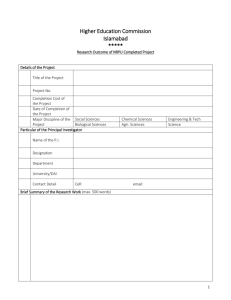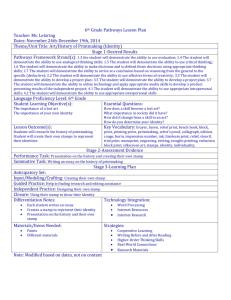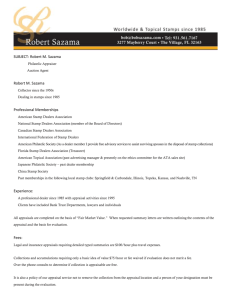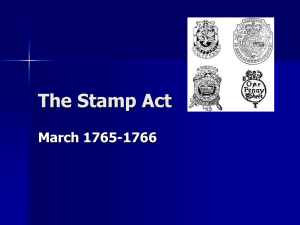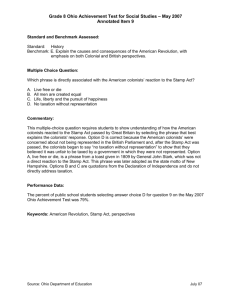Impact of Reduction of Land Registration Fee and Stamp Duties on
advertisement
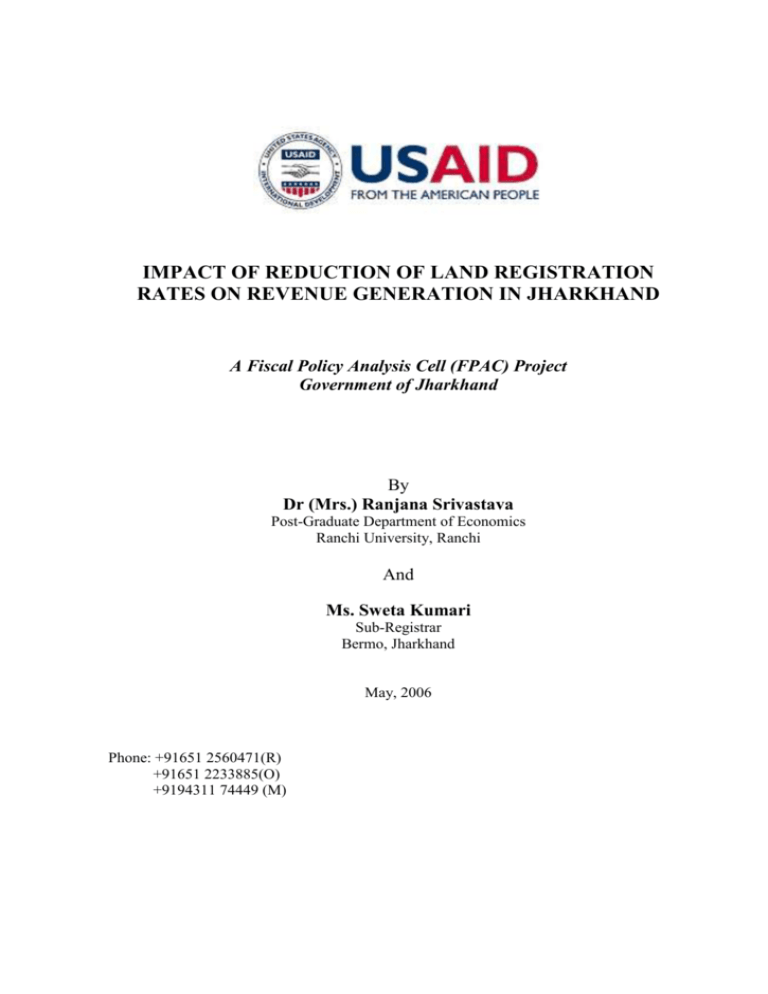
IMPACT OF REDUCTION OF LAND REGISTRATION RATES ON REVENUE GENERATION IN JHARKHAND A Fiscal Policy Analysis Cell (FPAC) Project Government of Jharkhand By Dr (Mrs.) Ranjana Srivastava Post-Graduate Department of Economics Ranchi University, Ranchi And Ms. Sweta Kumari Sub-Registrar Bermo, Jharkhand May, 2006 Phone: +91651 2560471(R) +91651 2233885(O) +9194311 74449 (M) Table of Contents Acknowledgement ........................................................................................................................ 109 List of Tables ................................................................................................................................ 110 Abstract ......................................................................................................................................... 111 Introduction .................................................................................................................................. 112 The Major Acts Administered By The Department: ............................................... 113 Acts Partially Administered By the Department: .................................................... 113 Brief profile of registration related aspects in Jharkhand ....................................................... 113 Instruments of registration ........................................................................................ 114 What is land registration ............................................................................................ 114 Objectives of the study ................................................................................................................. 115 General rationale behind reduction of stamp duty rates in Indian states including Jharkhand.................................................................................................................... 116 1. Increase in number of land registrations .......................................................... 116 2. Prevent under valuation of property................................................................. 116 3. Increase in revenue from land registrations ..................................................... 116 4. Revenue gains through links to other taxes ...................................................... 117 5. Reduction in black economy effect .................................................................... 118 6. Initiate urban real estate reforms ...................................................................... 118 7. Encourage transfers of resources to more productive uses ............................ 118 8. Registrations of apartments in the name of actual owners ............................. 119 9. Reducing the rates to bring them at par with other states .............................. 119 10. Reducing rates as per international norms .................................................. 120 11. Legalizing land ownerships .................................................................................. 120 Methodology for evaluation of impact of reduction in rates of registration ........................... 120 Impact of reduction of rates of land registration on major objectives .................................... 121 1. Effect on number of documents registered ........................................................... 121 2. Effect on revenue generated ................................................................................... 123 Limitations of the study ............................................................................................................... 125 Problems existing in land registration and suggestions for improving the efficiency of the department to enhance revenue generation. .............................................................................. 126 1. Temptations to postpone or avoid registration .................................................... 126 2. Absence of proper valuation monitoring cell ....................................................... 128 3. Misconceptions about title creation ....................................................................... 128 4. Shortages of staff ..................................................................................................... 128 5. Shortage of stamps .................................................................................................. 128 6. Slow pace of computerization of land records ..................................................... 129 7. Stamp duty rates too low for instruments other than conveyances ................... 129 8. Fraudulent practices in production (Telgi scandal of late 2003) and use of stamp papers ........................................................................................................................... 129 9. High individual compliance costs .......................................................................... 129 Government initiatives taken to revitalize the sector and increase revenue generation. ....... 129 Main conclusions .......................................................................................................................... 132 References ..................................................................................................................................... 134 Appendix ....................................................................................................................................... 135 Table 1: Maximum land registration rates in selected Indian states ..................... 135 Glossary ....................................................................................................................... 136 List of Abbreviations used.......................................................................................... 137 108 Acknowledgement We are grateful to Shri Mukhtiar Singh, Principal Secretary, Finance Department, Government of Jharkhand, & Ms. Alka Tiwary, Secretary Commercial Taxes, Government of Jharkhand, for initiating the study. Officers of the Registration Department of the state deserve thanks for providing necessary inputs for the study. Special thanks are due to Mr. B. B. Lal, Dr. Janusz Szyrmer, Dr. Brijesh C. Purohit and Perwej Alam of REFORM Project, USAID/India for their support & valuable suggestions in preparing the Report. Dr (Mrs.) Ranjana Srivastava Ms. Sweta Kumari 109 List of Tables Table 1: Land registration Rates in Selected Indian States …………………………….13 Table 2: Number of Documents Registered…………………………………………………….16 Table 3: Revenue Generated By Registration Department………………………….………..…17 Table 4: Actual Revenue Collection and Projected Revenue Collection ………………………18 110 Abstract The government of Jharkhand has taken a widely acclaimed decision to reduce the rates of stamp duty and registration fee on various types of instruments relating to land from an average of 17% to 5% of the consideration amount. The reduced rates have been effective from June, 2004. The registration department is an important revenue earning department of the state government, hence the revenue impact of this decision needs analysis. Apparently there has been a fall in revenue figures. As against 15 to 16 percent increase in earlier years there was fall in revenue collected by 11.4% in 2004-05 and a gradual increase by 3.9% in 2005-06. Assuming a 15% to 16% growth in revenue which existed with high rates, the loss of revenue to the department consequent to reduction of rates was Rs. 1119.28 Lacs and 2117.24 Lacs in 2004-05 and 2005-06 respectively. Linear regression analysis used for forecasting reveals that the loss of revenue to the department in 2005-06 was Rs. 1013.14 Lacs. It was expected that reduction of rates would cause considerable increase in number of documents registered. There was a spurt in these figures and 14.71% growth was recorded in 2004-05 as against -1.2% and 5.9% in the two preceding years. But the elasticity of registration with respect to rates in 2004-05 was less than one; thus in spite of reduced rates, the desired impact on revenue generation has not been realized. Also, the drastic reduction has not served the purpose of making the rates similar to the rates in other states in the country as in most of the states the rates of stamp duty vary between 7-10%. Immediate loss of Revenue through stamp duty due to substantial reduction of rates is as expected. Revenue collected by the department being only 5% to 6% of own tax revenue, the loss is not a matter of grave concern if the long run gains expected by the state are achieved. In due course of time loss of revenue to the department owing to reduction of rates may be overcompensated by an increase in tax revenues following a control on evasion, avoidance, undervaluation, fraud and black economy effect. Also, a positive effect on a number of taxes (collected by other levels of government also) is expected, which may be restored, in part, to the state through inter-governmental transfers. Increase in tax net by making a number of arrangements compulsorily registerable will also compensate for loss of revenue. It is premature to comment on the full revenue impact of reduction of rates of stamp duties. 111 Introduction Government of Jharkhand has taken a widely acclaimed decision to reduce the rates of stamp duty and registration fee on various types of instruments. The reduced rates have been effective from June 2004. The Registration Department is a revenue-earning department of the state government. In order of importance, it ranks next to Commercial Tax and Excise Tax Department of the state. A more promising aspect is that in most states the revenue from the Department has grown fairly steadily over time. A study of the buoyancy of specific revenue sources with respect to gross state product for selected states reveals that the highest average buoyancy (1.15) is for stamp duties and registration fees (James Alm, et al, 2004). As the rates have been reduced drastically from a high of an average of 17% to 5% of the consideration amount, there is a need to analyze the revenue impact of this decision. The reduction in rates is expected to have a positive impact on the number of land registrations executed. It is expected that the state will earn increasing revenue from the department. Apparently there has been a fall in revenue figures. However, this move would still be justified if the other objectives behind the reduction in rates were fulfilled. The main focus of this study is to analyze the effectiveness of the reduction of rates of stamp duty and registration fee in achieving its objectives, especially in increasing revenue. Registration Department is a non-plan department. The statutory basis of the Department is the Registration Act of 1908 which provides for a legal framework relating to the registration of documents. It collects revenue by way of stamp duty& registration fee on various types of instruments. It also registers societies, firms, and marriages. The Department also procures, stores and distributes various types of stamps (judicial as well as non judicial). The Registration Department is governed by a number of Acts, some of which are administered wholly by the department (state list) and others which it administers only partially (union list) 112 The Major Acts Administered By The Department: In these, the state government has the exclusive power to fix the stamp duties. These include: The Registration Act, 1908 (Central Act 16/1908) The Indian Stamp Act, 1899 (Central Act 2/1899) The Societies Registration Act, 1860 (Central Act 21, 1860) Acts Partially Administered By the Department: The Central Government sets the rates of stamp duties which are uniform across the states. These include: The Indian Partnership Act, 1932 (Central Act 9/1932) The Special Marriages Act, 1954 (Central Act 43 / 1954) The Hindu Marriages Act, 1955 (Central Act 25/1955) The Indian Christian Marriages Act, 1872 (Central Act 15/1872) The Registration Act 1908 also lays down the overall administrative framework for the Department. Secretary-cum-Inspector General of Registration (IG) heads the Department. A Deputy Secretary, Assistant Inspector General, Section Officer and other staff to assist. The field level setup comprises of Inspector of Registration offices, District Sub-Registrars, SubRegistrars and supporting staff. At present in Jharkhand there are 22 District Sub-Registrar offices and 7 Sub-Registrar offices. Brief profile of registration related aspects in Jharkhand The state governments in India impose a variety of stamp duties and registration fees on different kinds of transactions and instruments. For simplicity they are jointly referred to as ‘Stamp Duties’. A total of around 65 different kinds of such charges are imposed by the states. Stamp duties imposed under Indian Stamp Act, 1899, are a tax on the value of instruments used in various business/property transactions. They may be judicial or nonjudicial. Judicial Stamp Duties or Court Fees are fees collected for litigants in courts and are relatively small in magnitude. Non-judicial stamp duties are typically a one-time charge on transfer of immovable property. A registration fee is a payment made for specific service provided by government in recording contracts and deeds. However, registration does not entitle the payee to a guaranteed legal title. In most of the states, registration fees and nonjudicial stamp duties account for nearly 95% of revenue collected by the Department. 113 Instruments of registration Stamp duties (including registration fees) are imposed on instrument that generally fall into five major categories of instruments that relate to: Conveyance and property transfer Loans and advances Capital market transaction Daily business and commercial transaction Other statutes for record keeping purposes Like in most states, in Jharkhand also duty collected on conveyance accounts for 70% to 90% of total non-judicial stamp duty revenue. Hence such drastic reduction in rates will have a considerable impact on revenue generated by the department and a detailed analytical study is called for. What is land registration Land registration is governed by Indian Stamp Act of 1879. It is the process of recording a copy of a document, transferring the title to immovable property, in the office of the Registration Department. It acts as proof that a transaction has taken place. The registration of a document serves as a notice of the transaction, to the persons affected by the transaction. Registration also serves as an implied notice to any person subsequently acquiring interest in the property, covered by the registered document. When a document, which is compulsorily to be registered, is not registered, it fails to confer any title given by the document. The real purpose of registration is to ensure that every person dealing with property, for which compulsory registration is required, can confidently rely on the statement contained in the register, as being a full and complete account of all transactions by which the title may be affected. However, a certificate of registration is mere evidence that a document has been registered. It is not a proof that it has been executed. Such land records give land holders the fullest security of tenures and minimize the possibility of disputes and litigation. These also enable them to obtain credit more easily and 114 to transact in land more quickly, safely and cheaply. At the same time, the records secure the rights of absentees and also prevent the growth of unwanted and illegal land ownerships. Maintaining regular and updated land records are equally in the interest of the government. Despite the importance of land registration, it has been observed that land owners are refraining from the act possibly due to high rates. To overcome this, the government of Jharkhand took a bold step to drastically reduce the rates. Objectives of the study To establish the general rationale behind reduction of rates of stamp duties on land documents in Indian states including Jharkhand To estimate the loss/ gain in revenue collected through land registrations and stamp duty consequent to reduction of rates To analyze the impact of reduction of rates on number of documents registered To compare stamp duty rates in Jharkhand with other states in the country To highlight the problems faced by the department urgently calling for redressal in order to enhance revenue collection To appraise the steps taken by the government to revitalize registrations and increase revenue 115 General rationale behind reduction of stamp duty rates in Indian states including Jharkhand Reduction in registration rates from a high of 17% on an average to as low as 5% has been into effect by the notification no. 141 dated 31.05.2004 issued by the Inspector General Registrations, after receiving due legislative sanction. Though increase of revenue in the long run was the prime objective, there were certain other justifications also. This study analyses how far its various objectives have been fulfilled. The main objectives of reduction of rates were: 1. Increase in number of land registrations – Due to the high rates prevailing in the state, land owners evaded registrations after change of ownership took place. This not only caused loss of revenue to the government, but also made identification of true ownership of any land difficult. At the same time it was the cause of numerous litigations in the state. Reduction in rates makes buying and selling of property cheaper and hence brings an increase in the number of land registrations. 2. Prevent under valuation of property - As registration fees on various land documents are a certain percentage of consideration amount, reduction of rates lowers the burden of land owners and it lowers the incentive for under valuation of property, a major malady giving rise to loss of revenue and a number of illegal practices. For instance, in Maharastra it was estimated that there was 20% or more under valuation of 70% of stamp duty documents when rates were high. At times under valuation may approach 50% for many kinds of transactions. Studies conducted in other states show that under valuation responds to changes in stamp duty rates hence Government of Jharkhand reduced the rates of stamp duties on various types of land documents. Reduction of rates aims at reducing under declaration of property during transaction. 3. Increase in revenue from land registrations- The Registration Department is the third largest revenue earning department of the state earning between Rs. 63 crore to Rs. 84 crore in different years since inception of the state which is around 5% to 6% of its own tax revenue. It was felt that high rates prevailing in the state was the cause of nonregistration and undervaluation of property causing considerable loss of revenue to the state. Reduction in rates would bring an increase in revenue assuming that the number of 116 registrations would increase considerably and also under valuation will be checked specially in the major industrial cities like Ranchi, Dhanbad, Jamshedpur, Bokaro and Sarikela. This pre supposition is only tentative as experience in other states reducing rates has demonstrated bi-directional effect. Stamp duty rates in Rajasthan were lowered from 12% to 7 % in 1996-97 and the World Bank (2000) documented that revenue increased by 36% between 1996-97 and 1998-99. Dasgupta (2002) similarly found that in Karnataka there was positive revenue impact of stamp duty rates. In Jharkhand, apparently revenues have fallen. But the loss, in absolute terms is so small that state has not too much revenue to loose. In the long run it may in fact gain through increased revenue from other sources like income tax, property tax, etc. This bi-directional behavior is because tax revenue depends on a number of variables mainly rates of stamp duty and registration, value of property transacted and number of transactions. Value of property transacted being constant over a period of time, it was expected that fall in rates would bring, among other things, an increase in the number of transactions such that the revenue generated by the department would increase. 4. Revenue gains through links to other taxes – Reduction of rates and consequent prevention of under valuation of transaction for state governments stamp duties and registration fees has a positive effect on other taxes imposed by other levels of governments. a) Individual income tax, Capital Gains Tax, Gift Tax and Wealth Tax imposed by Central Governments: These depend directly upon valuation of property and reduced rates would have a positive impact on revenue generation. b) Property tax imposed by local governments (which vary between 10% to 20% of their own source revenue): In India, following the British tradition, the tax base of property tax is the “Annual Rentable Value” (ARV) or the annual rent that land and building might reasonably expect to receive in open market which is indirectly linked to the market value of sale of property. Undervaluation of property leads to property tax undervaluation. c) Sales tax imposed by the state government: Black money generated through undervaluation at the time of registration, is spent such that it is not officially recorded, causing considerably loss of sales tax revenue. 117 These revenue gains may not accrue directly to the state. Inter-governmental transfer may be necessary to ensure that the state revenue do not fall 5. Reduction in black economy effect: It is widely believed that given the high levels of stamp duties, transaction of many immovable properties are deferred, others are not recorded, and even those formally registered are under valued. This under valuation creates black money, as individuals involved must pay a part of the deal in cash such that it is not recorded in transaction. The undeclared money in possession of seller continues to circulate and gives rise to a number of other black transactions but escapes the tax net (income tax, sales tax, etc.). Recent estimates show that about 23% of GDP is in the black economy of India (Schneider, 2002). It is probable that reducing black economy effects may compensate loss of stamp duties due to reduction of rates. 6. Initiate urban real estate reforms- High rates reduce the responsiveness of real estate markets and thus have a distortionary impact. A Mckinsey Company study (2001) identifies rigid urban real estate markets as perhaps the single most important constraint on India’s ability to sustain the increased growth in the years since liberalization. In response to this significant urban challenge, the GOI has initiated a centrally driven urban real estate reform process for which an Urban Reform Initiative Fund (URIF) has been created, that rewards states that pursue market friendly real estate reforms like a progressive reduction in stamp duty on immovable property transfer in order to develop efficient and flexible urban real estate markets. Growing demand for urban land requires that private sector be encouraged to acquire agricultural, vacant or under utilized land and use it for development. High stamp duties are one of the impeding factors hence calls for reduction. States like Delhi, Gujarat, Karnataka, Maharashtra, Punjab and West Bengal had already taken steps to lower stamp duties at levels envisaged under URIF. Jharkhand has also acted accordingly. 7. Encourage transfers of resources to more productive uses: By reducing volume of transactions, high rates hinder the transfer of property, especially immovable, to more productive uses. An individual will generally like to purchase property in expectation of positive return but high stamp duties and other kinds of transfer comes in the way 118 of national capital from being distributed in most beneficial way to the community. Through productive property transfers encouraged by low rates of stamp duties, Jharkhand may enhance its growth rate. 8. Registrations of apartments in the name of actual owners: Reduction of rates of registrations would encourage people to get apartments registered in their own name instead of getting a general power of attorney from the builders. Seeing the substantial rise in real estate sector, especially construction of apartments in major cities after the creation of a separate state, the government expects a spurt of revenue from this sector. 9. Reducing the rates to bring them at par with other states – The basic stamp duty rates together with additional charges impose rates that demonstrate inter state variations. A glance at the rates prevailing in other states (Appendix Table-1) clearly shows that Jharkhand maintained very high rates of registration of various types of instruments leading to non-registration, illegal transfers and ownerships, and registration of certain instrument in neighboring states with low rates. Reduction in rates was a much awaited move. In fact similar rates of registration should be one of the principal objectives of The National Policy on Land Records. Rates of stamp duties1 vary across states (Appendix Table-1) and may be brought under three main categories. States like Andhra Pradesh, Maharashtra, Delhi, Tripura and Punjab fall in the low rate category (below 7%). States with rates of stamp duty 10% and above include Gujarat, Haryana, Uttar Pradesh and Orissa. In most states, rates vary between 7% and 10%. These include West Bengal, Manipur, Nagaland, Madhya Pradesh, Tamil Nadu, Goa, Himachal Pradesh, Assam, Kerala and Meghalaya. Jharkhand maintained average stamp duty and registration rates at around 17% which was the highest in comparison to all Indian states. Hence reduction in rates was called for. 1 There is no uniformity on base of valuation on which stamp duties are imposed. The frequently used bases are value, market value and agreement value/ consideration amount. 119 10. Reducing rates as per international norms – A review of stamp duties internationally indicate that Indian rates are relatively high and at times above 10%. In most of the countries the rates are less that 5%. Lower stamp duty rates are not limited to industrialized countries; countries like Vietnam and Phillipines have stamp duty rates in the range of 1-2%. Jharkhand accordingly reduced average rate of stamp duties from an average of 17% to 5% of the consideration amount. 11. Legalizing land ownerships – Most land owners purchase land after passing through the legal processes involved and are willing to get the same registered but high rates of registration and stamp duties come in the way. It was expected that reduction in rates would induce them to get the land registered and hence the legal ownership could be ascertained. However, this step may not cover a second class of land owners who acquire land through inheritance or some fraudulent method. High rates of registration are not a deterrent factor for them, rather non-registration is deliberate. Further action would be required to legalize this category of land. Methodology for evaluation of impact of reduction in rates of registration In the absence of quantitative information needed on various aspects the present analysis should be taken as qualitative & suggestive of the direction of the effects of the change in duties. Fundamentally, the stamp duty revenues (R) are a function of rates (t), average price of real estate (PRE) transacted and number of transactions in a given period (N). [R = f (t, PRE, N)] For purpose of government recording, PRE is constant over a period of time. Hence tax revenues may be assumed to depend on rates and number of transactions. The main hypothesis of this study is that fall in rates will increase the number of transactions such that there will be rise in stamp duty revenues. For analyzing the revenue impact of reduction in rates of registration of land documents, the main methodology used is forecasting, based on time-series approach. As 4 year period (the period since the formation of Jharkhand) is insufficient for analysis, quarterly figures have been used to increase data 120 point. The period considered for regression analysis & forecasting covers the 4 quarters for each of the years between 2001-04 and the 1st quarter of 2004-05 i.e. the period when high rates were applicable. Simple linear regression equation of Revenue Collection (Y1) over time (t) has been computed using OLS technique. The trend equation has been taken as a basis of projecting the revenue collected at future dates if the old (higher) rates were still applicable. Finally a comparison of these projected figures and actual collection figures after rate reduction, has been done to show the extent of loss of revenue to the government over the years due to reduction of rates. Revenue impact has also been analyzed by simple methods of % change. To analyze the impact of reduction of rates on number of document registered. Similar regression analysis using OLS technique has been attempted to estimate the linear trend of no. of documents registered (Y2) over time (t) & using similar forecasting technique as above, comparison of actual no. of registrations with the projected numbers has been made to comment on the effectiveness of the measure. Other techniques like elasticity and % change in no. of documents registered with respect to change in rates are used to explain the impact of reduction in rates of registration on revenue generated. Impact of reduction of rates of land registration on major objectives 1. Effect on number of documents registered Table 1: Number of documents registered* Financial Years No. Of Regd. Documents % Growth Actual Growth 2001-02 150160 - 2002-03 2003-04 2004-05 2005-06 159025 157193 180328 177192 5.9 -1.2 14.72 -1.74 8865 -1832 23135 -3136 * All types of registration documents Source: Department of Registration, Govt. of Jharkhand. (2006) In Jharkhand, about 95% of instruments of registration relate to land but bifurcated figures are not available therefore figures on total number of documents registered will be used in analysis. Whereas the change in number of documents registered was around 6% in 2002-03 and actually decreased by 1.2% in the following year, a reduction in rates caused a spurt in number and a 14.71% change was observed in 2004-05, the year in which reduction 121 in rates was affected. This is indicative of a positive impact of reduction of rates on number of documents registered. In 2005-06 however, the number of documents registered reduced by 1.74% in spite of the low rates still being applicable. This calls for further analysis. Forecasting based on linear Regression analysis of the number of documents registered (Y2) over time (t) has been done to compare the actual no. of registered deeds consequent to reduced rates, with the projected figures computed on basis of regression analysis in the period when the rates were high. Actual no. of documents registered with reduced rates have been much higher than the projected figures (based on the high rates). From the monthly figures of 2001-02 to 2003-04 linear trend equation obtained is Y2 = 148426.3 + 3516.5t (R2 = .5646, F = 1.29) …………………….….eq (i). The R2 and F values do not indicate a very good fit yet the analysis attempted gives an idea about the direction and extent of increase in no. of registered documents. If the linear trend in no. of documents registered continued, there would be only 160709.5 registrations, as against 180328 in 2004-05. In 2005-06, 164226 registrations are projected but 177192 documents have been registered. Thus number of documents registered has increased considerably. Revenue being a function of t and N, a further analysis on the basis of elasticity however shows that the increase in registrations consequent to fall in rates may not have the intended impact on revenue generation. Revenue would increase only if elasticity of registration with respect to rate is positive. However, this can be expected in a certain range of rates depicted as rising portion of the Laffer curve. Beyond a certain point revenues may not increase due to rate reduction. Thus expected positive outcome of rate reduction may be achieved largely through small reductions in rates. Jharkhand attempted a one-time drastic reduction hence positive revenue impact should not be expected, at least in the short run. Elasticity figures also support the above contention. Registration rates have fallen to almost one-fourth of the original (i.e. a change of 75%). But land registrations have not increased correspondingly. No. of documents registered increased by only 14.71% in 2004-05, the year in which the reduced rates were applicable. The Elasticity of Registration with respect to change in rates can be roughly computed to be as follows E = % change in no. of document registered % Change in rates of registration = 14.71 = .196 75 122 This indicates that even when registrations have responded positively to changes in rates (in 2004-05), they have not responded proportionately, implying that revenue impact of reduction in rates may not be positive. Figures of no. of documents registered in 2005-06 are even more disturbing. There has been an unprecedented fall of 3136 documents over the previous year; a negative growth by 1.74%. Thus fall in rates have not achieved its desired objective in terms of number of documents registered. The unstable relationship between rates of registration and number of documents registered indicates the relevance of other factors governing registrations and revenue generated there from. 2. Effect on revenue generated Table 2: Revenue generated by registration department Year Target (in Gross Revenue % Rs. Crore) (in Rs. crore) Achievement 2001-02 80 62.61 78.26 2002-03 90 73.10 81.22 2003-04 108 84.29 78.04 2004-05 125 74.62 59.7 2005-06 125 77.51 62.01 % Growth Increase In Actual Terms (In Crores) 16.8 15.3 -11.4 +3.9 10.49 11.19 -9.67 2.90 * Revenue from all sources Source: Department of Registration, Govt. of Jharkhand, 2006 A glance at the figures on revenue generated (Table 3) shows that there was a steep fall in the revenue generated in 2004-05, the year when stamp duty rates were reduced. Also the percentage achievement, which is the gap between target and actual revenue collection, has fallen from an average of 79% to 61% after reduction of rates. There has been a change in the nature of growth of revenue also. In the earlier years there was a steady growth of around 15% to 16% annually but in the very year when the rates were reduced there was a drastic fall of 11.4%. If the similar trend of 15% to 16% growth had continued the total revenue collected would have been between Rs. 8581.15 lacs to Rs. 8730.39 lacs in 2004-05. This implies that there has been a loss of revenue to the tune of Rs.1119.28 lacs to Rs. 1268.52 lacs. The projected revenue figures at 15% growth for 2005-06 would be around Rs. 9868 lacs as against the actual collection of Rs. 7751 lacs indicating a loss of Rs. 2117 lacs. A Regression Analysis may be attempted to estimate the linear trend equation of Revenue collected (Y1) over time (t) for the period before reduction in rates i.e. up to Q1 of 2004-05. This trend equation may be taken as the basis of projecting the revenue collected at 123 future dates if similar rates continued, assuming that no autocorrelation exists as per the assumptions of OLS technique. Finally the actual collection figures after rate reduction when compared to the projected figures will give an idea of the extent of loss of revenue to the government over the years. As four years figures are inadequate to attempt any regression analysis, quarterly figures are being used (Table 3). The linear trend equation over time for the period Q1 of 2002-03 to Q1 of 2004-05, the period with higher rates, is as follows: Y1 = 1834.047 + 24.62t (R2 = .1295; F = 1.04) Though the linear trend equation does not give a satisfactory fit, it is statstically the best possible fit. Also keeping in mind the nascent nature of data, the above basic model has been used in the analysis. Table 3: Actual revenue collection and projected revenue collection in lacs (on the basis of trend equation Y1 = 1834.047 + 24.62 t) Period Revenue Collected Projected Rev 2002-03 Q1 1940.83 Q2 1757.70 Q3 1674.70 Q4 1935.22 2003-04 Q1 2152.61 Q2 2283.05 Q3 1965.10 Q4 2042.47 2004-05 Q1 1864.06 Q2 1874.61 2080.26 Q3 1659.07 2104.88 Q4 2061.64 2129.50 2005-06 Q1 2076.28 2154.12 Q2 1836.66 2178.74 Q3 1805.01 2203.36 Q4 2033.12 2227.98 2006-07 Q1 2252.61 Q2 2277.23 Q3 2277.23 Q4 2301.85 Source: Same as Table 1 and Regression Results. Difference In Revenue Collection % Difference -205.64 -445.80 -67.85 -10.97 -26.87 -3.29 -77.84 -342.08 -398.35 -194.86 -3.75 -18.63 -22.07 -8.75 The linear trend equation projects revenue collection of Rs. 8764.23 lac for the year 2005-06 if the rates were not reduced, but the actual collection have been only Rs. 7751.08 124 lac indicating a loss of revenue of Rs. 1013 lacs. Moreover, the % difference between actual and projected figures has increased from 11.07% in 2004-05 to 13.07% in 2005-06. On the basis of the above analysis one can argue that the under performance of revenue has been due to drastic change in rates of stamp duties as in the short run the desired changes expected in number of registrations, extent of under valuation, etc. have not been achieved. 3. Effect on achieving parity in rates with respect to other states A study of the rates prevailing in the Indian States (Appendix Table 1) indicates that most states maintain rates between 7% to 10% of consideration amount (Assam, Goa, Gujarat, Himachal Pradesh, Kerala, Madhya Pradesh, Meghalaya, Nagaland, Rajasthan, Tamil Nadu & West Bengal). On either extreme are states like Uttar Pradesh, Orissa & Haryana which maintain exceptionally high rates and Andhra Pradesh, Delhi, Tripura & Maharashtra with very low rates. Jharkhand has made a one time drastic reduction from average of over 17% to 5% of consideration amount. This decision calls for a review especially in view of the negative impact on revenue generated. It is probable that small and gradual reductions could have had the desired impact on revenue generation. Maharashtra achieved a 36% increase in revenue between 1996-97 and 1998-99 by reducing rates from 12% to 7%. in 1996-97 (World Bank 2000) Limitations of the study It is premature to analyze the effect of reduction of rates on other objectives. Suitable models will have to be evolved which requires the use of alternative specifications derived from other variables. The nascent nature of data does not support such study. Lack of much quantitative information on important aspects like component of stamp duty revenues, components of types of documents registered, the proper valuation of property, and ways in which the stamp duty rates have changed over time, restrict the analysis and predictive power of the study. Over time, the revenue generated by the Department depends on a number of long run factors also. The full revenue impact can be analyzed only after analysis of a number of related aspects namely extent of reduction of under valuation, black economy effect, evasion, avoidance and fraud. The positive effect on revenue generation of other taxes and increase in state revenue through redistribution from other levels of government also affects revenue 125 generation in the long run. In the absence of data on above aspects the study is inconclusive on other factors affecting revenue generation consequent to reduction of rates hence full revenue impact cannot be ascertained. The Time series figures available for analysis cover a small period of four years, which provide inadequate degree of freedom for estimation. However quarterly figures have been used in Regression Analysis to find the trend of revenue collected and give the projections to estimate the extent of departure in these values after the reduction in rates. Though the results of the analysis have very low predictive power, the methodology evolved will serve as basis of study and projections in due course of time. Thus much of the analysis should be taken as qualitative and suggestive of general direction of the effects of the duties. If the relevant variables are moving in the direction of the desired change favorable impact may be expected in the long run. Problems existing in land registration and suggestions for improving the efficiency of the department to enhance revenue generation. 1. Temptations to postpone or avoid registration The Stamp Duty is one of the mainstay of Jharkhand Government. There are areas where the temptations to postpone or avoid registration is high as they are not compulsorily registrable. Through appropriate legislation the government can make some of the arrangements compulsory for registration, thereby enhancing its revenue. The main ones are: Family partitions and dissolution of partnership Transfer of possession Transfer of possession postpones registrations indefinitely under an agreement of sale or even under a Memorandum of Understanding (MOU). The compulsory registration of documents containing contract to transfer any immovable property deserves attention of the government in view of the fact that property transferred under contracts other than sale deed are not registered. Consequently evasion of payment of stamp duty on the property and gross loss of revenue to the Government takes place. This apart, transfer of property without their proper registration also creates confusion as to the claim of title thereby creating legal hassles to the vendee (buyer). In view thereof, some States like Gujarat and Rajasthan have since 126 amended section 17 of the Registration Act, 1908 to make it compulsory to register a contract. Agreement to sale It may be mentioned that property worth one hundred rupees or more are required to be registered after which mutation takes place. However, section 17 (2) (v) of the Registration Act, 1908 allows certain documents (which does not create, declare, assign, limit or extinguish any right, title or interest of the value of rupees one hundred or more in the immovable property) to transfer property without registration. The document of ‘agreement to sale’, in accordance with section 53A of the Transfer of Property Act, 1908 fall under the section 17 (2) (v). Thus, the same is not required to be registered. Power – of - attorney Transfer of property usually takes place under “power-of-attorney”. Power-of-Attorney is of two types i.e. General Power-of-Attorney (GPA) and Special Power-of-Attorney (SPA). Power of attorney, which is otherwise known as “letter-of-attorney” is an instrument authorizing another to act as one’s agent or attorney. Power of attorney empowers the attorney to sell immovable property on behalf of the principal (owner) in accordance with the Powers-of –Attorney Act, 1882, Sections 32 and 33 of the Registration Act, 1908. It allows the attorney to present documents on behalf of the principal for registration at the registration office. Registration of property transferred under Power of Attorney is not mandatory in view of the provisions laid down in section 53 A of the Transfer of Property Act, 1882 (popularly known as Power of Attorney deals). Thus, taking advantage of the fact that Power-of-Attorney does not transfer any title to the property to any other person nor is it compulsory to register the same, and even without registration, the same is a valid document; huge areas of land are still being transferred from one hand to another via the real estate players. Registration should be made compulsory on valid transfer of title so that registration not only becomes a valid evidence of title but also earns revenue to the state. “Part - performance of contract”. In accordance with part-performance of contracts, section 53A of the Transfer of Property Act, 1882, property sold through the instrument of contract may not be registered but it receives legal protection in accordance with “Part-II- Specific Performance of Contracts” of the Specific Relief Act, 1963. 127 Other common avoidance methods include: The use of an instrument of lease for the long term payment of rent The use of declaratory suit filed in court under which property is transferred through the court decree The use of an instrument of release in which a co-owner releases his or her share to another co-owner in exchange for some consideration The splitting of one property into smaller properties to avoid higher stamp duties rates The registration of properties in neighboring, lower-tax states 2. Absence of proper valuation monitoring cell In the absence of proper valuation monitoring cell the real values of property is never stated and as the prices have escalated since the formation of Jharkhand, there is a need to have a monitoring cell which regularly values various categories of property in each district to check tax evasion and bring due revenue to the state. 3. Misconceptions about title creation Like in other states, in Jharkhand also registration creates a large stamp duty liability but does not confer property rights. Hence there are strong incentives for non-registration. Jharkhand may follow Maharashtra in experimenting with a pilot programme in which the payment of registration fees provides legal protection of ownership & property rights, a system similar to the Torrens system drafted by Sir Robert Torrens, used in various countries like Australia, Thailand, U.K etc. (James Alm, et al 2004) 4. Shortages of staff At present there are only 19 District Sub-Registrars and 4 Sub-Registrars to head 22 district offices and 7 sub registry offices. In the absence of full time officers, officers in dual charge are heading these offices but since they are overburdened the due attention needed is not given towards revenue collection The major revenue earning districts should always have independent District Sub-Registrars. 5. Shortage of stamps Shortage of stamps, either manmade or insufficient supply, leads to black marketing. This is one of the maladies affecting the department. The department has decided to install 128 franking machines to do away with this problem. Two machines shall be installed in every district. 6. Slow pace of computerization of land records Implementation of an information technology project involving over 29 locations statewide is a formidable challenge. The JARS (Jharkhand Automated Registration System) project has to be implemented rapidly so that the technology (both hardware and software) does not become obsolete prior to the project launch. Implementation requires considerable re-engineering. 7. Stamp duty rates too low for instruments other than conveyances The stamp duty and fees rates for instruments other than conveyances like power of attorney, adoption, agreement to sale, revocation, cancellation settlement, etc. are too low in the state. Such unproductive sources raise the overall collection cost of the Department and hence their rates need to be revised so that additional revenue may be generated. 8. Fraudulent practices in production (Telgi scandal of late 2003) and use of stamp papers The high stamp duty rates raise the rewards of engaging in the fraud, both to the buyer and the seller of the stamps. Lowering stamp duties, administrative controls and use of franking machines will go a long way in checking these practices. 9. High individual compliance costs Paying stamp duties is a cumbersome, time taking, complicated process, hence there is a high incentive to avoid it. Simplifying the process & making registration a legal document will greatly increase the number of registrations. Government initiatives taken to revitalize the sector and increase revenue generation. 1. Reduction of rates This Act of the state government aims at fulfilling a number of objectives mainly increase in revenue, increase in number of registrations, legalizing the ownerships of land, 129 reducing undervaluation, evasion, fraud and black economy effect, bringing parity of stamp duty rates with other states, comply to GOI suggested reforms and fulfill international norms. 2. Updating of land records As a legacy of British rule Indian land records database is one of the best in the world. Through rational and scientific structuring it is possible to achieve a national spatial data infrastructure that presupposes integration of topographic and cadastral map data. Such data infrastructure will help in country level planning and give a range of information that can be utilized by government, private and voluntary organizations. Land administration in India deteriorated during the post-Independence period partly because of declining share of land revenue in own-tax revenues of state governments. Regular land surveys no longer happen. In some states, such as those in the north-east, land records simply do not exists, while in other states, they suffer from serious inaccuracies (Saxena 2005). With the Central Governments initiative COLR Project (Computerization of Land Records) updating of land records started in eight districts in 1988-89 in different states of the country with central government funding. The main objectives of this Project are Creating a data base of basic land records Facilitating issuing of copies of records Reducing work load by elimination of drudgery of paper work Minimizing the possibilities of manipulation of land records Creating land management information system After review of this project from 1988-2004 a Policy document VISION was issued which clearly stated that the progress of the programme across the country has been highly skewed. States like Karnataka, Goa, Madhya Pradesh, Rajasthan, Tamilnadu have done considerable work under the scheme. The review of Jharkhand along with the state of Bihar up to 2004 indicates that only 22% of total funds allotted for the project was utilized. But since then Jharkhand is striving hard and is presently working on full computerization of old records. 130 3. Computerization of land registration systems A number of transactions in purchase and sale of immovable property are conducted on day-to-day basis by the Revenue Department. Previously all these transactions were performed manually and there was traditional method to check the evasion of stamp duty. Now in the ages of information technology, computerization of all the registration offices is on the way. In fact, the district registration office at Ranchi has been fully computerized through a software package, JARS, on the pattern of BHOOMI, a software successfully implemented for computerization of land records in Karnataka. It will not only check the evasion of stamp duty, but also increase the efficiency in registration work, reduce cost and bring transparency in the system, stop fraudulent registration and help in proper maintenance of record of registration. It will substantially improve citizen interface and provide immediate electronic delivery of documents. Since 75% of the documents in Jharkhand pertaining to Encumbrance Certificates (ECs) and certified copies relate to agricultural properties, the success of the JARS project would greatly benefit the rural farming community. Agriculturists would also benefit from a possible link-up of the JARS network with the rural bank network, which would enhance the efficiencies of the rural credit services by eliminating the need for paper-based procedures. The National Registration Act of 1908, which did not contemplate the use of computers earlier to handle registration procedures, has been amended. 4. Training of staff of Registration Department Extensive system reforms cannot be brought about without adequate motivation within the organization. To use these new technologies effectively, Information Technology Department carries out a large scale and well-designed training program. A training program of 1-3 weeks was organized for different categories of officers and other staff. 5. Shortage of stamp papers To do away with the problem of shortage of stamp papers (real and artificial) and the resulting black marketing the government has decided to install two franking machines in each districts. 131 Main conclusions 1. There was a sudden rise by 14.71% in number of documents registered in 2004-05, the year in which fall of rates of stamp duty was brought into effect. However, in 2005-06 there was a sharp decline by 1.74% compared to the previous year. Thus no direct impact of reduction in rates of land registration on number of documents registered is observed. 2. The linear trend equation of number of documents registered over time projected that 160710 & 164226 documents would be registered in 2004-05 and 2005-06 respectively, but actual registration (after reduction of rates) was much more; 180328 & 177192 respectively. 3. The response of registration to reduction in rates is not very encouraging. 75% fall in rates brought only 14.71% increase in number of registration in 2004-05. The figures of 2005-06 are even more disturbing. 4. Revenue collection (R) is a function of rates (t), number of transaction in a given period (N) and average price of real estate (PRE). PRE being constant over a period of time (for the purpose of government recording), R depends on t & N. But elasticity of N with respect to t being less than one suggests a fall in R. 5. As against 16.8% & 15.3% increase in earlier years, there was a fall in revenue collected in 2004-05 (the year in which reduced rates were brought to effect) by 11.4%, which increased nominally by 3.9% in 2005-06. 6. Actual revenue collection has been much lower compared to projected figures (with high rates) computed on the basis of regression analysis using OLS technique. 7. The performance in 2005-06 needs further study. Whereas the number of documents registered decreased compared to previous year, the gross revenue collected by the department increased. Probably there was more registration of high-valued documents. Simple aggregated figures (of no. of documents registered & gross revenue collected) are insufficient for detailed analysis on this aspects. 132 8. Jharkhand has attempted a one time drastic reduction in rates of stamp duties from an average of over 17% to 5% of the consideration amount. The desired objectives could be achieved by moderate rates of 7% to 8%, like in most states in the country. 9. Jharkhand has achieved the international norm of rates of stamp duties less that 5%. But this should be backed by high compliance rate, administrative efficiency, check on evasion etc. to increase the productivity of the department. 10. Full revenue impact can be analyzed only after analysis of a number of related aspects namely, extent of reduction of under valuation, black economy effect, evasion, avoidance & fraud. In the long run, revenue generation by the state is also effected by a positive impact of reduction in rates of registration on other taxes collected by other levels of government, which can be restored in part to the state by redistribution. 133 References Appu, P.S. (1996), Land Reforms in India, Vikas Publishing House, New Delhi Appu, P.S. (1995), Report of the National Committee on Revitalization of Land Revenue Administration, Ministry of Rural Development, GOI, New Delhi. Dasgupta, Arindam (2002),”The Stamp & Registration Department in Karnataka: A Review of Institutions and Administration”, Indira Gandhi Institute of Development Research, Mumbai. Government of India, , Annual Reports from 1995-1999, Ministry of Rural Development, New Delhi. Government of India, Department-Related Parliamentary standing Committee on Home Affairs Seventy-Ninth Report, New Delhi Government of India (1999), VISION document, Ministry of Rural Development,New Delhi. Website: India Properties.com, Real Estate Ready Recknor James Alm, Patricia Annez, Arbind Modi (2004), “Stamp Duties in Indian States: A Case for Reform”, World Bank Policy Research Working Paper 3413, September. McKinsey Company Report: The Indian Growth Imperative (2001), New Delhi. National Institute of Public Finance & Policy (1995), Economic Reforms and the Stamp Act. ,New Delhi. Saxena, N.C. (2005) “Updating Land Records: Is Computerization Sufficient”, Economic and Political Weekly, 40(4). Schneider Fredrich (2002), “Size and Measurement of the Informal Economy in 110 countries around the world”, Paper presented at the Workshop of the Australian Tax Centre, ANU, Canberra, Australia, July 17, 2002. Singh, S.K. (2001), Dictionary of Land Revenue Terms in India, Greenfield Publishers, Dehradun United Nations (2002), World Urbanization Prospects: The 2001 Revision, New York World Bank (2000) “Rajasthan: Averting Fiscal Crisis and Accelerating Growth”, Draft Report, Poverty, New Delhi. 134 Appendix Table 1: Maximum land registration rates in selected Indian states STATE RATE OF STAMP DUTY Andhra Pradesh Assam 5% 8.25% Union Territory of Delhi 3% stamp duty + additional 5% as surcharge under Delhi Municipal Corporate Act, 1957. 8% Goa REMARKS Of the market value For agreement value Rs.1, 50,000/-. Of the value. exceeding For value more than Rs.1,000/On market value of Property. Gujarat For transfers other than in cooperative society in urban area. Haryana 10% 12.50% Value exceeding Rs.1, 000/- Himachal Pradesh 8% Value exceeding Rs.1, 000/- Karnataka i. For transfer other than in (ii) 10.50% On the market value of property exceeding Rs.1, 000/-. ii. For transfer affected by Bangalore Development Authority Act, 1976, relating to a flat More than Rs.5.00 Lakhs and up to Rs.15.00 Lakhs – Rs.20, 000/- + 6% for amount in excess of Rs.5.00 Lakhs. Kerala (Property situated within Municipal Corporation) Madhya Pradesh On market value. Value of consideration. 8.50% 7.50% Of the market value. Manipur Maharashtra Within Municipal limits of Greater Mumbai, Navi Mumbai, and Pune & Thane. Meghalaya 7% a. . Above Rs.5.00 Lakhs - 5% On market value of property. On the market value or the agreement value whichever is higher. Nagaland Orissa 7.50% 14.70% Of the value Punjab Rajasthan 6% 10% Of Agreement Value. Of the value. Tamil Nadu Tripura 8% 5% Of market value of property. Of market value. Uttar Pradesh Stamp duty 14.5 % under U.P. Town Improvement Act, 1919. Of the value. West Bengal 7%. Stamp duty on market value Jharkhand b. . Up to Rs.5.00 Lakhs - Rs.8, 750/- a. More than Rs.90, 000/- and up to Rs.1, 50,000/- - 8% b. . More than Rs.1, 50,000/- - 9.9% 16% (before reduction) 4% (after reduction) Source: India Properties.Com; Real Estate Ready Recknor. Of the market value. 135 Glossary Agreement - Every promise and every set of promises forming the consideration for each other, based on free consent of parties, lawful consideration and lawful object. Agreement Value - Amount settled between two parties on the value of property which may be at par or lower than market value. Consideration amount - It is the value of property declared is the office of the registrar and is the base for assigning stamp duties and registration fees . It is identical to the agreement value. Contract- An agreement enforceable by law Conveyance - A document that conveys property Deed - A written contract for agreement which has been signed under legal seal Document- It includes any matter written, expressed or described upon any substance by means of letter, figures or marks which is intended to be used for the propose of recording that matter. Government value - The minimum value the property fetches in the open market Instrument - That which includes every document by which any right or liability it purports to be created, transferred, limited, extended, extinguished or recorded. Judicial stamps/ court fees- Fees collected for litigants in court Land Registration- Process of recording a copy a document as per Registration Act 1908, transferring the title to immovable property, in the office of the Registration Department. Market Value - The maximum value the property fetches in the open market. Non-Judicial Stamps - One time charge on transfer of immovable property . Power of Attorney - The Act by which an execution authorises a person as an agent to act on his behalf. Registration fees- Payment made for a specific service provided by the government in recording contracts and deeds as per Registration Act 1908. 136 Stamp duties- Tax on the value of instrument used in various business / property transactions that are registrable as per Registration Act 1908. State list - Acts administered wholly by the Registration Department of the state where the state sets the stamp duty rates. Union List- Acts administered only partially by the State Governments where the Central Government sets the rates of stamp duties which are usually uniform across the states. List of Abbreviations used ARV Annual Rentable Value COLR Computerization of Land Records FY Fiscal Year (1st April to 31st March) GPA General Power of Attorney JARS Jharkhand Automated Registration System. SPA Special Power of attorney URIF Urban Reform Initiative Fund 137
